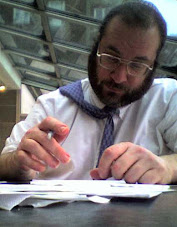It's a new semester at NYU (the first of my second year in the
Education and Jewish Studies PhD program here), and I'm starting to get excited again about my classes -- and my work here!

Last semester was my introduction to social science research methods, especially the kind favored by researchers interested in social change -- ethnography and in-depth interviewing -- and I started to get excited about the idea of doing that kind of work studying a rabbinical school or chaplaincy training program.
This semester, it looks like I'm going back for a bit to my philosophical, theological and textual (as in Jewish text study) roots. I'm really excited about a Philosophy of Education class I'm taking with
Rene Arcilla. In this class, it seems to me the prof wants to do something that is profoundly counter-cultural in today's
results! results! results! focused culture (educational and otherwise) -- he wants us to consider not how philosophy might help us raise kids' text scores, but rather how education might be a part of how we approach life in general. That is, how education might help us make our lives (individually and collectively) more 'good' and more human. . . . For a guy committed to a faith tradition that sets up Torah study as a central spiritual value and practice, that's a pretty exciting approach. Arcilla wants us to read some classical philosophical texts touching on education -- Plato, Rousseau, Dewey -- and to do with them what I want students to be able to do with classical Jewish texts: make them our own.
Arcilla thinks of this, in part, as a task of translation -- the task of translating our world/lives into the
language of these texts (to become "slightly bilingual," as he put it). The main task, he says, is to use these "historically distant" texts to help us examine our own perspective and assumptions. We should treat them as "messages in a bottle found on a beach" and not try and subject them to historical analysis, or try to read them in light of their historical contexts (something that might indeed be appropriate in a different class).
I'm looking forward to seeing how Arcilla does this, especially because it sounds so much like what I think the best Torah teaching is like. It has me thinking again about different directions or approaches for my own future dissertation work. It reminds me that much of my interest is rooted in the frustration I heard so often from other students in my rabbinical school career -- "why are we studying Talmud? What does this have to do with my future rabbinate?"
So often, the only answer teachers seemed to have was "trust me, it's important." A better answer, I think, is to say that Talmud study is about rabbinic/spiritual formation (and maybe, also, to be able to say something about how text study has formed
you, the teacher). That is, it's about learning to think like its authors -- to think (and feel and teach) like a rabbi. But that, alone, is not a good enough answer. And maybe my research will be about putting some "flesh" on the mere bones of that answer -- of working on formulating a better theory (backed by evidence!) of how Talmud (and other Jewish text) study
forms rabbis. What works and what doesn't -- and what kind of study forms the kind of rabbis we
want to form (ones, I hope, who have some pastoral and emotional sensitivity and depth, in addition to being smart and well versed in the Jewish tradition). [My first Talmud teacher, Devora Steinmetz, has written a great article about some of these issues -- where she claims that Talmud study helps create people prepared to routinely deal with the most difficult questions, the ones where there is no clear wrong or right answer -- but I don't think it's electronically available.]
I was just thinking of all this while I was reading an article for a class I'm taking on Talmud Narratives with the world's premier scholar on Talmud stories,
Jeffrey Rubenstein. In the article, Jacob Neusner discusses two famous rabbinic stories -- that of Honi the Circle maker (who audaciously demanded that God bring rain) and that of the escape of Yohanan ben Zakkai from the besieged Jerusalem to found the great rabbinic academy at Yavnah (where tradition tells us the first great document of rabbinic Judaism, the Mishna, was composed). Neusner's claim (once radical but now pretty much the conventional wisdom) is that these stories do not in any way depict actual historical events. They are written as
didactic tales -- stories to make a point, to teach a lesson.
That alone didn't really get my attention. But what did was Neusner's further claim that the stories' intended audience is rabbis -- they "project a picture of what a rabbi should be, which is a master of Scripture and Torah." [213] That is, they are stories
by rabbis, for rabbis.
I am excited about the days ahead!








